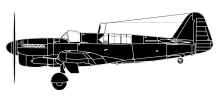
ASN Wikibase Occurrence # 242515
This information is added by users of ASN. Neither ASN nor the Flight Safety Foundation are responsible for the completeness or correctness of this information.
If you feel this information is incomplete or incorrect, you can submit corrected information.
| Date: | Sunday 14 September 1952 |
| Time: | day |
| Type: |  Fairey Firefly FR Mk 4 |
| Owner/operator: | 767 Sqn FAA RN |
| Registration: | VG986 |
| MSN: | F.8006 |
| Fatalities: | Fatalities: 0 / Occupants: 1 |
| Aircraft damage: | Destroyed |
| Location: | HMS Triumph, English Channel, off South Coast of England -
 United Kingdom United Kingdom
|
| Phase: | Landing |
| Nature: | Military |
| Departure airport: | RNAS Yeovilton (HMS Heron), Ilchester, Somerset (EGDY) |
| HMS Triumph, English Channel | |
| Confidence Rating: |
Fairey Firefly FR.Mk.4 VG986: Delivered to the FAA RN (Fleet Air Arm Royal Navy) at RNAS Culham RDU 10/10/1947. First issued for service 28/8/1948 to 816 Squadron RAN (Royal Australian Navy) at HMS Gannet, RNAS Eglinton, County Londonderry, Northern Ireland coded "238/JR" later "238/K" when embarked on board HMS Sydney.
816 Squadron RAN disbanded at Eglinton 24/3/1949, and VG986 was next issued to 737 Squadron FAA RN on 30/3/1949 coded "208/GN" when in service until at least 30/9/1949. Withdrawn from service to Fairey Aircraft Ltd at Hamble for overhaul by/in January 1950.
Refurbished and returned to service in June 1950 with 767 Squadron FAA RN at HMS Heron, RNAS Yeovilton, Ilchester, Somerset. Transferred 3/12/1951 to 799 Squadron HMS Landrail, RNAS Machrihanish, close to Campbeltown in Argyll and Bute, Scotland until at least 28/2/1951. Returned to 767 squadron FAA RN at HMS Heron, RNAS Yeovilton, Ilchester, Somerset by/in July 1952.
Written off (damaged beyond repair) 14/9/1952 in a landing accident aboard HMS Triumph. Pilot lost sight of DLCO (Deck Landing Control Officer), cut engine late, and collided with both safety barriers. Pilot - Lieutenant P.J. Spelling - survived uninjured.
At the time, HMS Triumph was in the English Channel off the south coast of England, conducting trials with an angled flight deck ("In 1952, Triumph was used for the first trials of an angled flight deck. Her original deck markings were obliterated and replaced with new ones at an angle to the long axis of the ship. The success of these trials led to the development of the now-standard design, with additional areas of the flight deck added to the port side of the ship".)
Firefly VG986 was declared damaged beyond economic repair, and struck off charge as Cat.ZZ on 28/9/1952
Sources:
1. Fleet Air Arm Fixed Wing Aircraft Since 1946 (Ray Sturtivant, Lee Howard & Mick Burrows, Air Britain, 2004 p,259)
2. http://www.ukserials.com/results.php?serial=VG
3. http://www.wings-aviation.ch/36-Australia/2-Aircraft/Fairey-Firefly/Fighter.htm
4. http://www.adf-serials.com.au/n1.htm
5. https://www.faaaa.asn.au/fairey-firefly-aircraft-histories/
6. http://www.wings-aviation.ch/36-Australia/2-Aircraft/Fairey-Firefly/Fighter.htm
7. https://en.wikipedia.org/wiki/HMS_Triumph_(R16)#Remainder_of_service
Revision history:
| Date/time | Contributor | Updates |
|---|---|---|
| 16-Sep-2020 23:00 | Dr. John Smith | Added |
| 17-Sep-2020 19:36 | Digger | Updated [Aircraft type, Operator, Destination airport, Operator] |
Corrections or additions? ... Edit this accident description
The Aviation Safety Network is an exclusive service provided by:


 ©2024 Flight Safety Foundation
©2024 Flight Safety Foundation